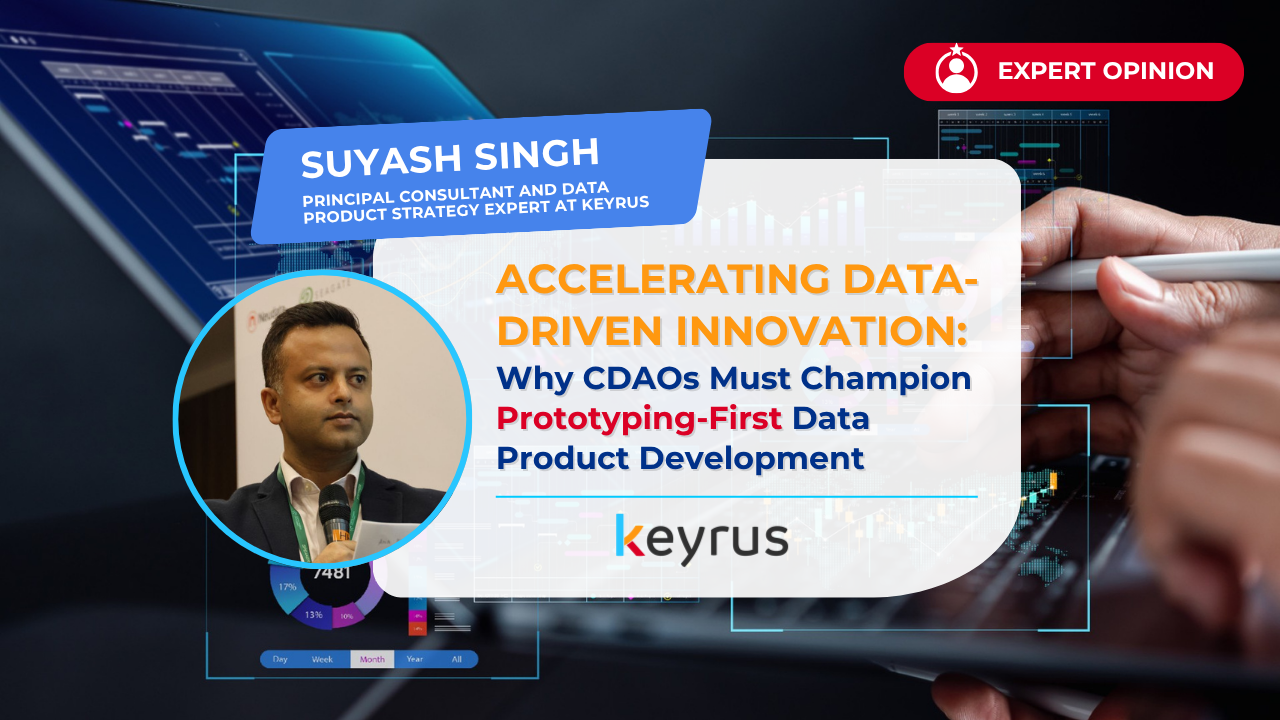Transform your data product strategy with rapid prototyping methodologies that deliver 30% faster time-to-market
In an era where data velocity determines market leadership, Chief Data and Analytics Officers (CDAOs) and Chief Information Officers (CIOs) face an unprecedented challenge: Bridging the gap between ambitious data strategies and executable business outcomes.
Traditional waterfall approaches to data product development are proving inadequate in today's fast-paced digital economy, where speed-to-insight often takes precedence over perfection. The statistics are sobering. According to recent industry research, 87% of data science projects never make it to production, and those that do often take 6-12 months longer than initially projected.
For enterprise leaders tasked with demonstrating ROI from data investments, this represents not just operational inefficiency but strategic vulnerability.
The Strategic Imperative: From Concept to Value at Enterprise Scale
Why Traditional Data Product Development Falls Short
Enterprise data initiatives traditionally follow a linear progression: extensive requirements gathering, technical architecture design, development, testing, and deployment. This approach, while thorough, creates several critical pain points for executive leadership:
Delayed Business Value Realisation: Extended development cycles mean business stakeholders wait months before seeing tangible results, creating scepticism around data investments and eroding executive support for future initiatives.
Resource Allocation Inefficiencies: Technical teams become bottlenecks, with business analysts and product owners waiting for engineering resources to validate even basic concepts, leading to suboptimal resource utilisation across the organisation.
Misaligned Business Requirements: By the time products reach end-users, business needs may have evolved, resulting in costly redesigns and scope creep that impact both budget and timeline commitments.
The Prototyping Paradigm: A Strategic Framework for Data Excellence
Progressive enterprises are adopting a fundamentally different approach—one that prioritises rapid iteration, early validation, and business-driven design. This prototyping-first methodology represents a strategic shift from technology-led to business-outcome-led data product development.
The Four-Pillar Framework for Prototyping Excellence
1. Strategic Definition and Scoping: Business-First Approach
The journey begins with laser-focused business alignment. Rather than extensive technical documentation, successful organisations prioritise:
Value-Driven Requirements: Collaborating directly with Product Owners and subject matter experts to define measurable business outcomes
Rapid Feasibility Assessment: Conducting lightweight technical assessments to validate data availability and transformation complexity
Stakeholder Alignment: Ensuring executive sponsors understand both the potential value and resource requirements upfront
2. Agile Prototyping and Validation: Democratising Data Product Design
This phase represents the most transformative aspect of the methodology. By empowering business analysts and product owners with low-code/no-code platforms, organizations achieve:
Accelerated Concept Validation: Business users can directly manipulate data, test scenarios, and validate assumptions without waiting for technical resources
Iterative Refinement: Rapid feedback loops enable continuous improvement of data transformations and business logic
Early Stakeholder Engagement: End-users interact with functional prototypes, providing valuable input before significant technical investment
3. Industrialisation Acceleration: From Prototype to Production
The validated prototype becomes a comprehensive blueprint for technical teams, including:
Pre-Validated Business Logic: All transformation rules and data quality requirements are tested and approved
Automated Code Generation: Modern platforms can translate prototype logic into production-ready SQL, Python, or other languages
Reduced Technical Risk: Engineering teams focus on optimisation and scalability rather than requirement interpretation
4. Governance and Scaling: Center of Excellence Leadership
Sustainable success requires institutional capabilities:
Standardised Methodologies: Establishing consistent approaches across business units
Reusable Solution Templates: Building a library of proven patterns and components
Skills Development: Training business users on prototyping tools while maintaining technical excellence
Quantifying the Business Impact: ROI Metrics That Matter to Executives

Enhanced Business Engagement: 53% Reduction in Feedback Cycles
Traditional approaches often result in lengthy feedback cycles once products reach business users. Prototyping methodologies enable:
Early Validation: Business stakeholders engage with functional prototypes rather than technical specifications
Reduced Rework: Issues identified during prototyping cost significantly less to address than post-deployment changes
Improved User Adoption: Products developed with continuous business input achieve higher adoption rates
Technical Efficiency Gains: Streamlined Testing and Deployment
By resolving logic and data quality issues during prototyping:
Reduced Testing Overhead: Fewer critical issues emerge during formal testing phases
Simplified Deployment: Technical teams can focus on performance optimisation rather than functionality debugging
Lower Maintenance Burden: Well-validated business logic results in more stable production systems
Delivery Acceleration: 32% Faster Time-to-Market
Organisations implementing prototyping-first approaches report significant acceleration in data product delivery. This translates directly to:
Faster Revenue Recognition: Earlier deployment of revenue-generating analytics capabilities
Competitive Advantage: Quicker response to market opportunities and threats
Resource Optimisation: More efficient allocation of scarce technical talent
Technology Enablement: Choosing the Right Platform for Enterprise Success Platform
Capabilities for Executive Consideration

Modern analytics platforms like Alteryx Analytics Cloud exemplify the technical capabilities required to support enterprise prototyping initiatives in the following ways:
Business-Accessible Design Environment: Workflow-based interfaces enable business users to design and test data transformations without extensive technical training, reducing dependency on scarce engineering resources.
Integrated Data Intelligence: Built-in profiling and analysis capabilities provide immediate visibility into data quality and transformation impact, enabling informed decision-making throughout the design process.
Production Translation Capabilities: Advanced platforms can automatically generate production-ready code from prototype designs, ensuring seamless handoff between business and technical teams while maintaining code quality and performance standards.
Enterprise Governance Framework: Role-based access controls, audit trails, and approval workflows ensure that business empowerment doesn't compromise data security or regulatory compliance.
The Keyrus Advantage: Accelerating Your Prototyping Transformation
At Keyrus, we understand that successful prototyping implementation requires more than technology—it demands organisational change management, technical expertise, and strategic vision. Our approach combines:
Strategic Consulting Excellence
Executive Workshop Facilitation: Helping leadership teams define prototyping success metrics and organizational readiness assessments
Operating Model Design: Developing governance frameworks that balance business agility with technical rigor
Change Management Support: Guiding organisations through the cultural transformation required for business-led data product development
Technical Implementation Expertise
Platform Selection and Implementation: Leveraging deep experience with leading prototyping platforms to accelerate deployment
Skills Development Programs: Training business analysts and product owners on prototyping methodologies while upskilling technical teams on industrialisation best practices
Center of Excellence Establishment: Creating sustainable capabilities for ongoing prototyping success
Proven Delivery Methodology
Our proprietary framework combines industry best practices with real-world implementation experience, ensuring:
Rapid Time-to-Value: Initial prototyping capabilities deployed within 6-8 weeks
Scalable Foundation: Architecture and governance designed for enterprise-wide adoption
Measurable ROI: Clear metrics and KPIs that demonstrate business value to executive stakeholders
Implementation Roadmap: Your Path to Prototyping Excellence
Phase 1: Foundation and Pilot (Months 1-3)
Executive alignment and success criteria definition
Platform selection and initial deployment
Pilot project identification and team formation
Initial skills development and change management
Phase 2: Validation and Expansion (Months 4-6)
Pilot project execution and results measurement
Lessons learned, integration, and methodology refinement
Additional use case identification and prioritisation
Governance framework implementation
Phase 3: Scale and Optimise (Months 7-12)
Enterprise-wide deployment and adoption
Center of Excellence establishment
Advanced capabilities development
Continuous improvement and optimization
Conclusion: The Strategic Imperative for Data Leaders
In today's competitive landscape, the organisations that thrive will be those that can rapidly translate data insights into business action. Prototyping-first data product development represents a fundamental shift from traditional approaches, enabling businesses to achieve faster time-to-market, improved business alignment, and more efficient resource utilisation.
For CDAOs and CIOs, the question isn't whether to adopt prototyping methodologies, but how quickly they can implement them effectively. The organisations that master this approach will establish sustainable competitive advantages in their respective markets, while those that maintain traditional development cycles risk falling behind more agile competitors. The transformation requires both strategic vision and tactical execution.
By partnering with experienced consultants who understand both the technical requirements and organisational dynamics involved, enterprises can accelerate their journey toward data-driven excellence while minimising implementation risk. The future belongs to organisations that can rapidly prototype, validate, and deploy data products that drive measurable business outcomes.
The question for today's data leaders is simple: Will you lead this transformation, or will you be disrupted by those who do?
About the Author

Suyash Singh is a Principal Consultant and Data Product Strategy Expert at Keyrus UK, where he specialises in data strategy and analytics transformation for enterprise clients. With over a decade of experience in data architecture, product development, and organisational change management, Suyash has helped numerous Fortune 500 companies accelerate their data-driven transformation initiatives.
At Keyrus, Suyash leads the development of innovative methodologies for rapid data product development and has been instrumental in establishing prototyping frameworks that have delivered measurable ROI for clients across financial services, retail, and manufacturing sectors. He holds advanced certifications in leading analytics platforms and regularly speaks at industry conferences on topics related to data product management and enterprise analytics strategy.
